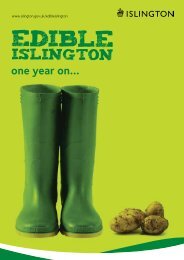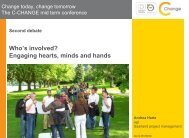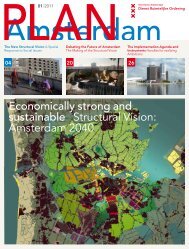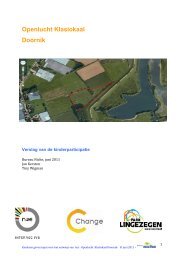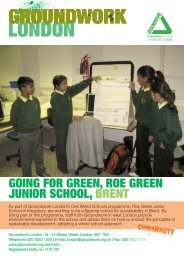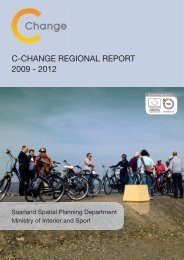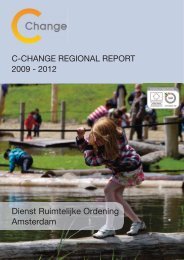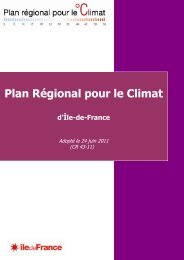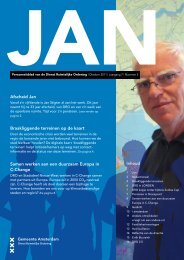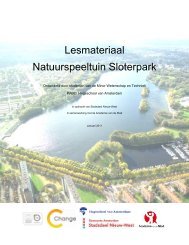Playground âDe Wildernisâ Sloterpark, Amsterdam - C-Change
Playground âDe Wildernisâ Sloterpark, Amsterdam - C-Change
Playground âDe Wildernisâ Sloterpark, Amsterdam - C-Change
You also want an ePaper? Increase the reach of your titles
YUMPU automatically turns print PDFs into web optimized ePapers that Google loves.
C-<strong>Change</strong> Project<br />
C-CHANGE: OBJECTIVE 1 CASE STUDY - TEMPLATE<br />
How can citizens, communities and all stakeholders be actively engaged in practical<br />
responses to climate change?<br />
EJPG 1A<br />
Member’s name: Wiebe van der Veen Date: September 2011<br />
Title of the Partner project<br />
<strong>Playground</strong> “De Wildernis” <strong>Sloterpark</strong> area, <strong>Amsterdam</strong><br />
Summary project description<br />
General information on the Nieuw-West City District of <strong>Amsterdam</strong><br />
The Nieuw-West City District of <strong>Amsterdam</strong> is the local authority of the ‘Western Garden<br />
Cities’ (Westelijke Tuinsteden), which were built as part of the post war ‘New West’<br />
expansion of the City of <strong>Amsterdam</strong>. This part of <strong>Amsterdam</strong> is characterised by<br />
numerous green spaces, encompassing large open areas and water reservoirs, as well as<br />
a wealth of parks and conservation areas. The built up area is dominated by typical postwar<br />
middle- and low-rise buildings. The District has a growing, multicultural population.<br />
Of the132.974 inhabitants, 60% of the residents are categorised as minority groups. The<br />
yearly family income is 15-20% below the Dutch average. Almost a quarter of the<br />
families are earning the minimum wage. Above national and <strong>Amsterdam</strong> average<br />
numbers of households are living on welfare in the City District.
<strong>Sloterpark</strong> area<br />
The <strong>Sloterpark</strong> is a large green area in the middle of the Western Garden Cities of<br />
<strong>Amsterdam</strong>. A huge deep lake in the centre characterizes the area. From original it is a<br />
dredged lake for the raising of the surrounding residential area.<br />
The park is currently not fully used; this applies to the surrounding residential<br />
neighbourhoods as well as to the rest of <strong>Amsterdam</strong>. In the structure vision of <strong>Amsterdam</strong><br />
the park has to be developed as an attractive area for recreation for the citizens of the<br />
Western Garden City and the people of <strong>Amsterdam</strong>. In addition, the water in the Sloterplas,<br />
especially in the summertime has a poor quality due bleu algae’s. Bleu algae’s has many<br />
causes, both by excess off nutrients from the streets (from dogs and the excessive feeding<br />
of the gooses around the lake), the lack of ground vegetation through carps and the<br />
concrete walls surrounding the lake. At present the city wants to improve this by making<br />
natural bank the lake and reed filtering areas.<br />
With the creation of the natural playground in this area, the City of <strong>Amsterdam</strong> aims to raise<br />
the awareness of communities and individuals on climate change issues, such as energy,<br />
biodiversity, water about. To educate young people on climate change is important. The<br />
playground is located in the middle of a triangle with a children’s farm, a nature and<br />
educational centre and a botanical garden. The development of the playground has been<br />
part of a series of projects to enhance the attractiveness of the Sloterplas area. There will be<br />
a disc golf course, different playgrounds, recreation areas and two renewed harbours.<br />
Methodology:<br />
We selected a non-profit foundation “Stichting (foundation) Alexander”, specialized in<br />
participation processes with children, to assist us with developing the design of the natural<br />
playground in a co-creation process with children, parents, experts and stakeholders.<br />
Stichting Alexander and the designer of the city district had to include themes like climate<br />
change and health in the design of a natural playground. The landscaper and the<br />
participation officer worked in close cooperation in line with those themes. The project team<br />
worked actively together to develop a design for the playground with a sound social basis, a<br />
design that would meet the demands of the neighbourhood and the district council.
The following methods were used:<br />
Street interviews in Nieuw-West<br />
Street interviews in <strong>Amsterdam</strong><br />
Tinker afternoon in Nieuw-West<br />
Junior creation team<br />
Senior creation team<br />
Stakeholders<br />
Children’s press office<br />
Parents panel<br />
> children, parents from the neighbourhood<br />
> children, parents from de rest off <strong>Amsterdam</strong><br />
> children from the neighbourhood<br />
> children, day care<br />
> professionals from the field<br />
> professionals, including politicians<br />
> schoolchildren from the neighbourhood<br />
> parents<br />
Street interviews<br />
The first contact with the neighbourhood and the city was through street interviews. We have<br />
interviewed 25 children, parents, child keepers and grandparents. These interviews made<br />
crystal clear that the participants found it difficult to imagine a natural playground.<br />
Conversations about what you can do in a natural playground and showing some images<br />
helped a lot. The existing lack of knowledge was an important outcome of these interviews.<br />
More creative approaches were desirable.<br />
Rig up afternoon<br />
In the second phase, we decided to organize a rig up afternoon at the annual neighbourhood<br />
festival. Children made their own playground with natural materials like twigs, moss and<br />
cork. We decided to show images of natural playgrounds to explain what it is. With great<br />
enthusiasm the children created about 30 designs. The interviews with the “designers” of the<br />
models and their parents showed that the idea of a natural playground would count on a lot<br />
of sympathy.<br />
Junior creation team<br />
During the first meeting, the team gained more in-depth knowledge of natural playgrounds.<br />
We visited a natural playground. Before the meeting the children got no information on the<br />
visit. We could observe their first reactions. In the beginning the children were free to play.<br />
After it, we asked questions about what they liked and what they didn’t like. In the second<br />
meeting we asked the children to make designs of a natural playground. The third and last<br />
meeting of the junior creation team was an interactive afternoon with parents, professionals<br />
and politicians. The children presented their models and wishes for the new playground.<br />
About 40 people were involved in this phase.<br />
Senior creation team<br />
The senior creation team consisted of a mix of professionals, parents and NGO’s. We invited<br />
28 persons. Nobody showed up on the evening itself. This was partly due to cancellations,<br />
sickness or other commitments. None of the Moroccan and Turkish mothers came, despite<br />
intensive counselling and reconfirming. After contacting this group we found out that this<br />
group finds it difficult to say “no”. On top of that the meeting place was to formal. We decided<br />
to organize a special parents meeting at a school to engage the Moroccan en Turkish<br />
women as well.<br />
Stakeholders meeting<br />
At the stakeholders meeting, representatives of 7 different organisations were present.<br />
Again the attendance was low. This time apparently because no financial compensation was
offered. The meeting itself was very good and creative. It delivered lots of ideas for the<br />
project team.<br />
Children’s press agency<br />
The children’s press agency is embedded in the curriculum of one of the neighbourhood’s<br />
primary schools. During half a year a group of 15 children (age 9 to 11) got lessons on a<br />
natural playground, they made interviews with different stakeholders, like de landscape<br />
architect, the alderman of the city district, with people on the street etc. The report is<br />
available on the website www.natuurspeeltuinsloterpark.nl<br />
Parents panel<br />
Input of parents, with a Moroccan and Turkish was still lacking. We decided to discuss the<br />
playground in a meeting of mothers at one of the schools in the neighbourhood. They are<br />
used to meet there and to talk about different topics. We discussed the natural playground in<br />
one of these meetings and got insight in the ideas and dreams of this heard to reach group.<br />
The meeting was very successful with a lot of comments on the design of the playground.<br />
Results of participation:<br />
Excitement and adventure<br />
Especially the children would love excitement, adventure, action and discovery in the<br />
playground, risks and areas to hide. They imagined games, they would normally do, but with<br />
an extra element such as mud, water, building huts in the nature, swinging on ropes,<br />
climbing trees, running and moving. Besides that they would also like an area to relax.<br />
Feeling of nature<br />
Parents talked about addressing the senses of children. Children should be encouraged to<br />
explore nature. It is good to combine education with the feeling of feeling at one with nature.<br />
Children, especially the girls like to nurse animals, watching and observing nature, birds, live<br />
of insects, feeding ducks etc. The girls would like a place with flowers to relax.<br />
Diversity<br />
The playground should offer a place for small children and older children. In addition to that<br />
children would like separate places for boys and girls. Girls preferred more contemplative<br />
places, watching and observing nature, flowers and critters. Boys dreamt of places to<br />
explore, climb, run and fly through the nature.<br />
Education<br />
Many parents indicated that the natural playground would have an added value by<br />
constructing the playground with natural materials to have the feeling to be in nature.<br />
Education seemed interesting to them. Education has to follow playing. The playground is in<br />
first intention a place to play in a natural environment. Learning about nature and climate<br />
change is an outcome of playing. Parents find it important that children learn about nature<br />
and their environment, about what grows, flourishes and dies in the nature such as flowers,<br />
plants, birds, insect and animals. Children said they like education in the playground. The<br />
elements to play in the playground are very important and leading, like a search with<br />
questions about nature and keys for following.<br />
Safety and supervision<br />
Parents find security important. They made a distinction between physical and social safety.<br />
Concerning physical safety they worried about accidents, the level of the water to play with,<br />
to keep dogs away, climbing in trees and on rocks can be dangerous. They suggested to<br />
look for a soft underground. Social safety: make a demarcation to keep street children away.<br />
Closing times will make it easier to keep street children away from the playground. The
children want to feel secure and safe. It is remarkable that safety and monitoring has been<br />
an issue for children as well as parents. The children want their own space without suffering<br />
from vandalism and loitering youth. Parents indicated that it is important to have supervision.<br />
They like to watch the children playing. Children had an opposite meaning in this case.<br />
They like to hide while they are playing.<br />
Maintenance and sustainability<br />
When the participants, and also the professionals, spoke about safety they also highlighted<br />
maintenance. The water has to be clean, garbage has to be removed and the used materials<br />
have to be clodhopper proof.<br />
Information and promotion<br />
A returning theme in the participation process is to give sufficient information what you can<br />
do in the playground and which activities are organised. A good way to do this is on schools,<br />
libraries etc. Also a map of the playground on the spot would be helpful.<br />
2 Engagement<br />
During the participation process we explicitly sought for a way to get commitment for the<br />
playground and its specific purpose, to communicate and empower on climate chance. At all<br />
events climate change issues were communicated. After the primary design we made the<br />
final design. During the process of developing the design and construction we have had and<br />
will have regular consultations with the “friends of the Sloterplas”, a local NGO. The<br />
participation process delivered a list of people who like to help with the making and the<br />
maintenance of the playground<br />
3 Responses to climate change<br />
Points out of the participation, you can find back in the design of the playground are:<br />
<br />
<br />
<br />
<br />
<br />
<br />
<br />
<br />
<br />
<br />
<br />
<br />
<br />
<br />
challenging<br />
safe<br />
clean<br />
social play<br />
being alone<br />
some kind of water play<br />
hide & seek<br />
seasons<br />
routing<br />
seating areas<br />
supervision<br />
entrees<br />
toilet<br />
learning about nature while playing
Design off the playground, for more details look at the presentation or the website<br />
www.nieuwwest.amsterdam.nl<br />
4 Recommendations:<br />
The physical proximity of activities in de immediate surroundings:<br />
Children and parents are more inclined to participate it it’s about developing facilities nearby.<br />
Continuity of activities:<br />
Continuity of activities works. When children, parents and professionals come multiple times<br />
together for participation activities they feel more free to give their own opinions and ideas<br />
after a while. This is especially true for the children’s press agency and the junior and the<br />
senior creation teams.
Look at preferences of participants, versus kind of interaction:<br />
The activities have to be exactly tuned to the preferences of the audience. It generates more<br />
enthusiasm to contribute. For children it is very important to do things and to show them<br />
examples of what you want. For the professionals (adults) it works better to describe and to<br />
talk about the conditions of the design. In general adults pay also more attention to the use,<br />
safety, maintenance, effect on the environment, added value comparing to the existing<br />
environment. They have less attention for the physical play possibilities<br />
Availability of images to support creativity:<br />
Especially with a relatively unknown phenomenon as a natural playground, visual materials<br />
(photographs, images, maps) help to inspire participants to give their own ideas and<br />
inspirations. By showing images the curiosity towards materials, the use of materials,<br />
sustainability, climate change and the influence of our own behaviour on the climate<br />
improved.<br />
It is important to be clear about conditions and criteria at the start of the participation<br />
process, such as the cycle of water, the principle of natural filter to clean the water (filter of<br />
reed to clean the water), the story telling aspects of the used materials, the educational<br />
storytelling on climate change in the playground.<br />
The transnational aspect of the design<br />
The project group has also made visits, to the Wetterpark, close to Frankfurt and visits to<br />
different gardens in London. The team was inspired by toolbox with lessons on climate<br />
change as developed by the Frankfurt partner. Further on Heidrun Stern, an outstanding and<br />
price winning landscape architect from Saarbrücken advised on the draft design of the<br />
playground. She recommended for example to organize activities with the local communities<br />
during construction. The idea of an herb garden is partly inspired by developments in the<br />
area, which by means of the vegetable growing in your own neighbourhood, social<br />
awareness about nature is encouraged. The new playground is part of a cycling route<br />
through Nieuw-West, the eatable map of <strong>Amsterdam</strong> Nieuw-west.<br />
www.nieuwwest.amsterdam.nl/buurtmoestuinen. Recently we made a face book account.<br />
Furthermore, we will plant a phonological tree in the garden. It has that has sisters and<br />
brothers in de different regions of the C-<strong>Change</strong> project.<br />
A comprehensive report on the participation process is available on the C-<strong>Change</strong> website.<br />
There is also an attachment (English) of a presentation on the design and the key design<br />
principles as outcome of the participation process.
5. Further information about the project<br />
Address<br />
Physical Planning Department <strong>Amsterdam</strong><br />
t.vankoeverden@dro.amsterdam.nl<br />
City Council <strong>Amsterdam</strong> Nieuw-West<br />
w.van.der.veen@nieuwwest.amsterdam.nl<br />
Participation process: Tarik Pelhivan, St. Alexander<br />
Landscaper (designer): Caroline Elbers, city council <strong>Amsterdam</strong> Nieuw-West<br />
Projectmanager playground: Wiebe van der Veen, City council <strong>Amsterdam</strong> Nieuw-West<br />
Projectmanager C-<strong>Change</strong>: Truke van Koeverden, DRO <strong>Amsterdam</strong><br />
Carried out in 2010<br />
Useful links:<br />
www.st-alexander.nl<br />
www.dro.amsterdam.nl<br />
www.nieuwwest.amsterdam.nl



